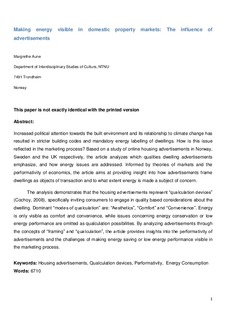| dc.contributor.author | Aune, Margrethe | |
| dc.date.accessioned | 2017-11-13T12:34:38Z | |
| dc.date.available | 2017-11-13T12:34:38Z | |
| dc.date.created | 2012-11-14T18:53:14Z | |
| dc.date.issued | 2012 | |
| dc.identifier.citation | Building Research & Information. 2012, 40 (6), 713-723. | nb_NO |
| dc.identifier.issn | 0961-3218 | |
| dc.identifier.uri | http://hdl.handle.net/11250/2465820 | |
| dc.description.abstract | Increased political attention towards the built environment and its relationship to climate change has resulted in stricter building codes and mandatory energy labelling of dwellings. How is this issue reflected in the marketing process? Based on a study of online housing advertisements in Norway, Sweden and the United Kingdom, respectively, an analysis examines which qualities dwelling advertisements emphasize, and how energy issues are addressed. Informed by theories of markets and the performativity of economics, insights are generated on how advertisements frame dwellings as objects of transaction and to what extent energy is made a subject of concern. The analysis demonstrates that the housing advertisements represent ‘qualculation devices’ specifically inviting consumers to engage in quality-based considerations about the dwelling. Dominant ‘modes of qualculation’ are: ‘aesthetics’, ‘comfort’ and ‘convenience’. Energy is only visible as comfort and convenience, while issues concerning energy conservation or low energy performance are omitted as qualculation possibilities. By analysing advertisements through the concepts of ‘framing’ and ‘qualculation’, this paper provides insights into the performativity of advertisements and the challenges of making energy saving or low energy performance visible in the marketing process. | nb_NO |
| dc.language.iso | eng | nb_NO |
| dc.publisher | Taylor & Francis Group | nb_NO |
| dc.title | Making energy visible in domestic property markets: the influence of advertisements | nb_NO |
| dc.type | Journal article | nb_NO |
| dc.type | Peer reviewed | nb_NO |
| dc.description.version | acceptedVersion | nb_NO |
| dc.source.pagenumber | 713-723 | nb_NO |
| dc.source.volume | 40 | nb_NO |
| dc.source.journal | Building Research & Information | nb_NO |
| dc.source.issue | 6 | nb_NO |
| dc.identifier.doi | 10.1080/09613218.2012.696784 | |
| dc.identifier.cristin | 962245 | |
| dc.relation.project | Andre: 16 | nb_NO |
| dc.relation.project | Egen institusjon: 11 | nb_NO |
| dc.relation.project | Norges forskningsråd: 209697 | nb_NO |
| dc.description.localcode | © 2012 Taylor & Francis. This is the authors' accepted and refereed manuscript to the article. | nb_NO |
| cristin.unitcode | 194,62,40,0 | |
| cristin.unitname | Institutt for tverrfaglige kulturstudier | |
| cristin.ispublished | true | |
| cristin.fulltext | postprint | |
| cristin.qualitycode | 2 | |
